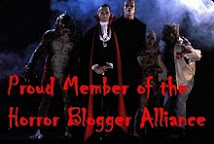One of the struggles I've had with putting together Hammer Films month is the obvious one: a lot of people simply don't know what Hammer Films IS. I will admit, despite how much I love their films, I've missed out on a lot of their history too. Until now. Lately, I seem to be swimming in it.
Thus, I present a relatively simple Midnight Top Five - compiled primarily by scouring Wikipedia and other potentially ill-repute sites, I admit - that breaks down some of the developments that interest me most about the beginnings of Hammer's reign in genre cinema. I hope to make a similar post later in the month that covers the horror years of the company, but for now, let's just take a trip down memory lane.
The Very Beginning - The company was registered in 1934 by William Hinds, who named the company after his own stage name - Will Hammer. The first film produced by Hammer was The Public Life of Henry the Ninth, which was released in 1935. The company made five films between 1935-1937 (including The Mystery of the Marie Celeste/The Phantom Ship, which starred Bela Lugosi), but was forced into bankruptcy in 1937. During that span, Hinds and Enrique Carreras formed their own film distribution company - Exclusive Films - which continued to function while Hammer was not producing films.
The New Beginning - The company was joined by the sons of the founders, James Carreras and Anthony Hinds in 1938. Both men left the company to fight in World War II, but returned in 1946. They began producing "quickie" films in 1947, which were primarily crime dramas and radio adaptations.
Hammer made strides toward its future in genre cinema in the upcoming years, hiring director Terence Fisher for the first time in 1951 (the film was The Last Page) and making their first sci-fi films in 1953 (Four Sided Triangle and Spaceways). Most significantly, the studio began using the studio that would become the world famous Bray Studios in 1951, and it would become the home of Hammer Films through 1966.
The New Hammer's First Horror Wasn't a Monster Flick - While their Draculas and other monsters are well known, the beginning of Hammer's horror age was the production of The Quatermass Xperiment in 1955. The film was directed by Val Guest, and became a huge hit - spawning the equally successful 1957 sequel Quatermass and the Pit. The films have been identified as a childhood inspiration for future horror maestro John Carpenter, which clearly makes their existence wicked awesome in The Mike's eyes..
(BONUS FACT! Both Quatermass films were adapted from the works of Nigel Kneale, who would go on to work with Carpenter by writing the original script behind Halloween III: Season of the Witch. However, Kneale would go uncredited on that film, as he objected to the violence and gore added by producer Dino De Laurentiis.)
Dracula Didn't Happen Next - Hammer's first take on the classic monsters was not their most famous one. It was The Curse of Frankenstein, which was the first Hammer pairing of Christopher Lee (as the Monster) and Peter Cushing (as Victor Frankenstein). (BONUS FACT! The two had already appeared in two other films together - Laurence Olivier's Hamlet and the original Moulin Rouge.)
The Film almost didn't happen, because initial scripts were hated by the producers. A future Hammer hero rose, thankfully: Jimmy Sangster, who wasn't a writer two years earlier, rewrote the film and won over the producers. Terence Fisher would direct, and Sangster would go on to write about 25 more films for Hammer. The film was a huge hit, and was one of the first horror films to really focus on the letting of blood.
So, Dracula Was An Easy Follow Up, Right? - NOT SO FAST. Universal was quite reluctant to give up rights to the Dracula tale, and no agreement that would allow the film was made - until after the film had been shot. Even though Frankenstein had succeeded, Hammer had to battle to get funding for Horror of Dracula, and also faced trouble from those who felt its use of blood was inappropriate (the British Board of Film Classification wondered why "vampires need be messier eaters than anyone else.") (BONUS FACT! The producers also were worried about the production design being so different from Universal's sets, and almost fired designer Bernard Robinson during filming. Robinson would work on Hammer films for at least the next decade, including Curse of the Werewolf and The Phantom of the Opera.)
Of course, the film was a huge success worldwide, and Universal made a lot of money on distribution. In August of 1958, it was announced that Universal had given Hammer "the remake rights to their entire library of classic films".
The rest, as they say, is history. Until next time, that is.
Subscribe to:
Post Comments (Atom)

















4 comments:
being a horrorhead & not knowing about Hammer is like being a human & not knowing you possess genitalia...
I love Hammer films! Probably my favorites are The Brides of Dracula, The Curse of the Werewolf, and Countess Dracula.
Hammer gave us the unbeatable combination of Cushing and Lee. This makes me want to dig out my copy of The Legend of the 7 Golden Vampires, The Curse of Frankenstein, The Mummy, and The Satanic Rites of Dracula and have a marathon!
Dreaded Dreams
Petunia Scareum
The work of director Terence Fisher is notable too! He is wrongly forgotten by cinephiles. His directing was strong and confident. He deserves way more recognition!
Thanks all! Glad to see the Hammer love!
@Michael - Completely agree. I'm working on a post about Fisher and his films for later in the month!
Post a Comment